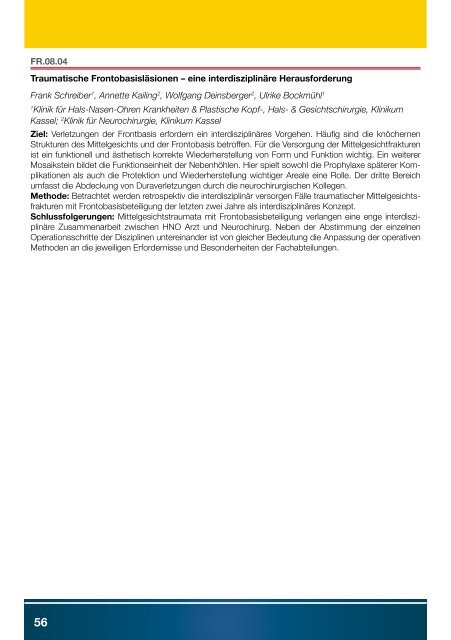Programm www .dgsb2010 .de
Programm www .dgsb2010 .de
Programm www .dgsb2010 .de
Erfolgreiche ePaper selbst erstellen
Machen Sie aus Ihren PDF Publikationen ein blätterbares Flipbook mit unserer einzigartigen Google optimierten e-Paper Software.
FR.08.04<br />
Traumatische Frontobasisläsionen – eine interdisziplinäre Herausfor<strong>de</strong>rung<br />
Frank Schreiber1 , Annette Kailing2 , Wolfgang Deinsberger2 , Ulrike Bockmühl1 1Klinik für Hals-Nasen-Ohren Krankheiten & Plastische Kopf-, Hals- & Gesichtschirurgie, Klinikum<br />
Kassel; 2Klinik für Neurochirurgie, Klinikum Kassel<br />
Ziel: Verletzungen <strong>de</strong>r Frontbasis erfor<strong>de</strong>rn ein interdisziplinäres Vorgehen . Häufig sind die knöchernen<br />
Strukturen <strong>de</strong>s Mittelgesichts und <strong>de</strong>r Frontobasis betroffen . Für die Versorgung <strong>de</strong>r Mittelgesichtfrakturen<br />
ist ein funktionell und ästhetisch korrekte Wie<strong>de</strong>rherstellung von Form und Funktion wichtig . Ein weiterer<br />
Mosaikstein bil<strong>de</strong>t die Funktionseinheit <strong>de</strong>r Nebenhöhlen . Hier spielt sowohl die Prophylaxe späterer Komplikationen<br />
als auch die Protektion und Wie<strong>de</strong>rherstellung wichtiger Areale eine Rolle . Der dritte Bereich<br />
umfasst die Ab<strong>de</strong>ckung von Duraverletzungen durch die neurochirurgischen Kollegen .<br />
Metho<strong>de</strong>: Betrachtet wer<strong>de</strong>n retrospektiv die interdisziplinär versorgen Fälle traumatischer Mittelgesichtsfrakturen<br />
mit Frontobasisbeteiligung <strong>de</strong>r letzten zwei Jahre als interdisziplinäres Konzept .<br />
Schlussfolgerungen: Mittelgesichtstraumata mit Frontobasisbeteiligung verlangen eine enge interdisziplinäre<br />
Zusammenarbeit zwischen HNO Arzt und Neurochirurg . Neben <strong>de</strong>r Abstimmung <strong>de</strong>r einzelnen<br />
Operationsschritte <strong>de</strong>r Disziplinen untereinan<strong>de</strong>r ist von gleicher Be<strong>de</strong>utung die Anpassung <strong>de</strong>r operativen<br />
Metho<strong>de</strong>n an die jeweiligen Erfor<strong>de</strong>rnisse und Beson<strong>de</strong>rheiten <strong>de</strong>r Fachabteilungen .<br />
FR.08.05<br />
Endoscopic transsphenoidal resection of non-functioning pituitary<br />
macroa<strong>de</strong>nomas: should we search for the plane of cleavage<br />
between the capsule and the arachnoid membrane?<br />
Kartik G. Krishnan1 , M Leinung2 , Hartmut Vatter1 , Timo Stoever2 , Volker Seifert1 Departments of 1Neurosurgery and 2Otorhinolarnygology, Johann Wolfgang Goethe University,<br />
Frankfurt<br />
Introduction: Some factors predictive of recurrence or regrowth [of a remnant] of non-functioning pituitary<br />
macroa<strong>de</strong>nomas (NFPMA) are invasion of the cavernous sinus precluding total removal, absence of immediate<br />
radiotherapy after initial neurosurgery, and immunohistochemical features of the tumor . It has been<br />
shown that the recurrence rate after total removal of NFPMAs is significantly lower than the rate of regrowth<br />
of remnants after subtotal tumor <strong>de</strong>bulking . Endoscopic surgery, with its wi<strong>de</strong>ned, precise visualization of<br />
the operative field permits the i<strong>de</strong>ntification of the plane of cleavage between the tumor capsule and the<br />
arachnoid membrane, <strong>de</strong>pending on the tumor consistency .<br />
Methods: Among 13 patients that un<strong>de</strong>rwent endoscopic transnasal transsphenoidal tumor resection<br />
for NFPMAs invading or tangentiating the cavernous sinus during the past year, a clear plane of cleavage<br />
between the tumor capsule and the arachnoid membrane could be i<strong>de</strong>ntified and taken advantage of in 4<br />
patients (relatively solid tumor consistency playing a major role) . The endoscopic surgical mobilization of this<br />
plane of cleavage enabled secure separation from the cavernous sinus wall and complete tumor removal<br />
(MRI) in these patients .<br />
Results: No surgical complications were encountered in any of the patients . Visual acuity and field of vision<br />
improved in all patients . CSF leak, DI or other endocrinological complications were not encountered . No<br />
relapse could be observed in the group with total extracapsular resection during the short-term follow-up<br />
(6-8 months) . Long-term follow-up is awaited .<br />
Conclusion: Endoscopic surgery of the sellar region (as opposed to microsurgery) offers the unique possibility<br />
of increased field of vision, high resolution and magnification, all of which enable the clear i<strong>de</strong>ntification<br />
of the plane of cleavage between the tumor capsule and the arachnoid membrane, which is only seldom<br />
the case in the microsurgical approach . Extracapsular mobilization enables complete tumor removal and<br />
will reduce recurrence rates, as already shown in several studies . Our initial experience shows no complications<br />
associated with such manipulation .<br />
56 57


